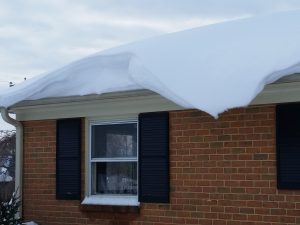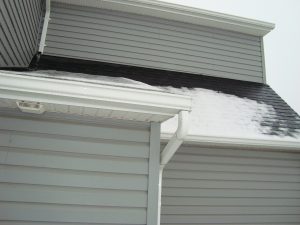You don’t need to worry, your roof is going to be fine – probably…
With the recent snow fall there have been a couple of roofs that have collapsed. This has led to a LOT of questions about how much snow a roof can hold in our area. With some snow drifts getting 4′-5′ tall – how much snow is too much? You don’t need to worry, your roof is going to be fine – probably…
The first thing to consider is that a roof in the valley is designed to hold 43 pounds of snow per square foot when built to current building code. On the other side of the mountain, a roof is designed to hold 30 pounds per square foot of snow. So how does this measure up to reality? This snow was rather light or dry – which weighs around .5 pounds per inch per square foot. So a roof designed to current building codes will support around 7′ of snow in the valley. If the snow had been a heavier “wet” snow it could weigh as much as 1 pound per square foot. So this denser snow could become a problem at 3′-6″. It does not mean you will have a collapse, but you might have a problem if snow reaches these depths.

Some things that can impact these numbers include damage to trusses from faulty installation or rot from water intrusion over time. Wind added to the heavy loads can also impact how the roof will react during the storm. Pushing a heavy load in the same direction changes how the building performs.

When asked about snow loads on roofs in our area James Halstead, our in-house structural expert, said “In light of the recent snow storm and the collapse of several roofs around the area, homeowner’s, for the most part, should not be concerned about the stability of their structure. Although, if they have a flat roof, and a means of safe entry, it would be beneficial to remove as much snow as possible. The same idea would apply to an exterior deck. If by chance, homeowner’s start to view drywall cracks in the exterior walls or ceilings, or notice moisture spots that were not visible before the storm, consult with a local Architect, Builder or Structural Engineer for an evaluation.”

So why have we seen roofs collapse during this storm? It could be that the building was not maintained properly over time and water intrusion has caused damage to the structural system. It could be that the drifts exceeded the design code at the time the structure was built. It could be that the building was an agricultural use and does not have a code minimum standard.
So before the next storm, it may be beneficial to have a home inspector look at your roof system to verify no damage has been done by this storm. If you see any new cracks or water leaks it should certainly be checked.




